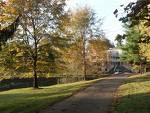
I am still with my thoughts in Louisiana with Mary Ann Hardey. This is a picture of a bayou and one remembers how frightened St. Philippine Duchesne and her companions were when they were overtaken by a canoe full of Indians. The Indians went past but Philippine feared that they were waiting for them further on and was so glad to at last arrive at Grand Coteau, but I am getting ahead of my story. Mary Ann Hardey will be one of the first pupils there. But the story of her life is only to be continued on Monday.
Today we are going to visit one of our Sisters who moved to our retirement home at Oakwood last year. She is back and visiting her niece who lives in Central Florida so we will drive up, have lunch, and return home tomorrow. I saw her last summer and she loves being out at Oakwood, but misses family, I think, and California is a long way from Miami.
When I was growing up we would always spend Sundays at my paternal grandmother's. She would have her six children all there every Sunday for dinner and then games. That lasted until I was in sixth grade and there was a shortage of gas plus my baby brothers came along and that made visiting more difficult. Instead, my maternal grandfather, great aunt, and great uncle, all began to come to our house on Sunday afternoons for a roast dinner. It just made Sunday a family day. Now, we are usually together on Sundays as a community and prayer together at six in the evening.
When I was growing up, the stores were not open on Sunday and families stayed home!
Here is a something you will like - I had read it before, but now it is sent to me with the source by my spiritual director:
We awaken in Christ's body
as Christ awakens our bodies,
and my poor hand is Christ, He enters
my foot, and is infinitely me.
I move my hand, and wonderfully
my hand becomes Christ, becomes all of Him
(for God is indivisibly
whole, seamless in His Godhood).
I move my foot, and at once
He appears like a flash of lightning.
Do my words seem blasphemous? -- Then
open your heart to Him
and let yourself receive the one
who is opening to you so deeply.
For if we genuinely love Him,
we wake up inside Christ's body
where all our body, all over,
every most hidden part of it,
is realized in joy as Him,
and He makes us, utterly, real,
and everything that is hurt, everything
that seemed to us dark, harsh, shameful,
maimed, ugly, irreparably
damaged, is in Him transformed
and recognized as whole, as lovely,
and radiant in His light
he awakens as the BelovedSt. Symeon
-- from The Book of Mystical Chapters: Meditations on the Soul's Ascent from the Desert Fathers and Other Early Christian Contemplatives, trans. John Anthony McGuckin. Boston: Shambala Publications, 2002.
































